
Streamlined Onboarding Processes
|
October 17, 2025
|
7 Essential Features of Employee Training Management Software
Overview
You might be wondering what makes employee training management software so essential. Well, it’s all about features like:
- Instant SOP creation
- Real-time tracking
- Automated workflows
- Access to expert content
- Compliance monitoring
These tools are designed to boost training efficiency and effectiveness.
Now, let’s dive into how these features can really make a difference! They lead to:
- Improved employee performance
- Increased engagement
- Higher compliance rates
And guess what? All of this ultimately drives organizational success! So, if you’re looking to enhance your training processes, these tools could be just what you need.
Key Highlights:
- SowFlow enables instant creation of Standard Operating Procedures (SOPs), enhancing workforce management and training.
- Intelex streamlines employee training management, tracking progress and ensuring compliance with industry regulations.
- Real-time tracking provides immediate insights into employee performance, boosting engagement and productivity.
- Automated workflows reduce manual tasks by up to 50%, allowing employees to focus on strategic goals.
- Access to expert training content improves educational programmes, increasing productivity by up to 20%.
- Data analytics in training programmes leads to a 40% boost in staff performance and a 24% increase in profit margins.
- Compliance tracking is essential for regulatory adherence, with ongoing development programmes increasing compliance by 60%.
- Integrating EHSQ management into training processes simplifies operations and enhances safety compliance.
- Centralised training management software improves EHSQ outcomes, reducing compliance violations by 20%.
- Engaged employees lead to a 70% decrease in safety incidents, underscoring the importance of effective training programmes.
Introduction
In the fast-paced world of business, you might be wondering just how crucial effective employee training management really is. Well, organizations are catching on that investing in solid training software isn’t just a nice-to-have; it’s essential for boosting workforce skills and keeping up with industry standards.
So, let’s dive into seven must-have features of employee training management software that can shake up your training processes, ramp up engagement, and ultimately enhance overall performance.
But with so many options out there, how can you figure out which features will genuinely elevate your training initiatives and help cultivate a culture of continuous improvement?
SowFlow: Instant SOP Creation for Effective Training Management
You might be wondering how to . Well, SowFlow has got you covered! It offers a unique way to generate instantly, which is super important for . By letting organizations quickly record their processes, SowFlow slashes the time spent on creating instructional materials. Plus, it ensures that all employees can easily .
This handy feature doesn’t just make a breeze; it also supports the . Imagine everyone being on the same page with the —that’s what SowFlow can help you achieve! So, why not ?
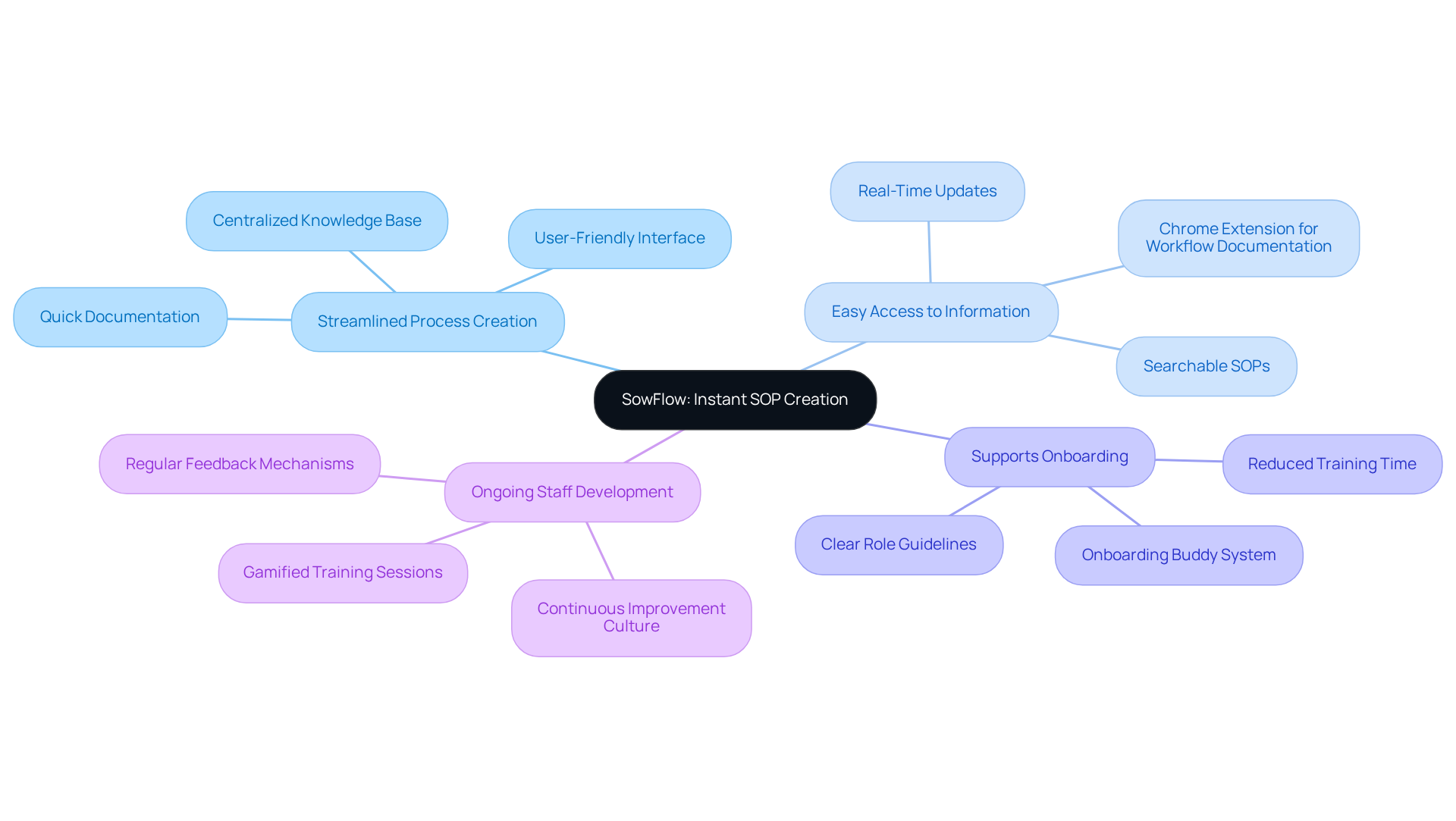
Intelex Training Management Software: Streamline Training Processes and Compliance
You might be wondering how Intelex Management Software can make a difference in your . Well, it’s expertly designed to streamline everything while keeping you in line with industry regulations. With its user-friendly interface, enables companies to easily set up educational sessions, track employee progress, and —all in one place!
By bringing these together, Intelex helps create a structured educational environment that really cuts down the risk of non-compliance. And here’s something to think about: organizations that use advanced development oversight systems can see by up to 30%! That’s a significant improvement, especially when you consider that 60% of staff feel unprepared regarding compliance standards. Clearly, the use of employee training management software to manage instruction efficiently is more important than ever.
As businesses recognize the need for robust development solutions, employee training management software like Intelex is becoming a must-have for maintaining regulatory standards and . So, if you’re looking to enhance your educational processes while ensuring compliance, why not explore what Intelex has to offer?
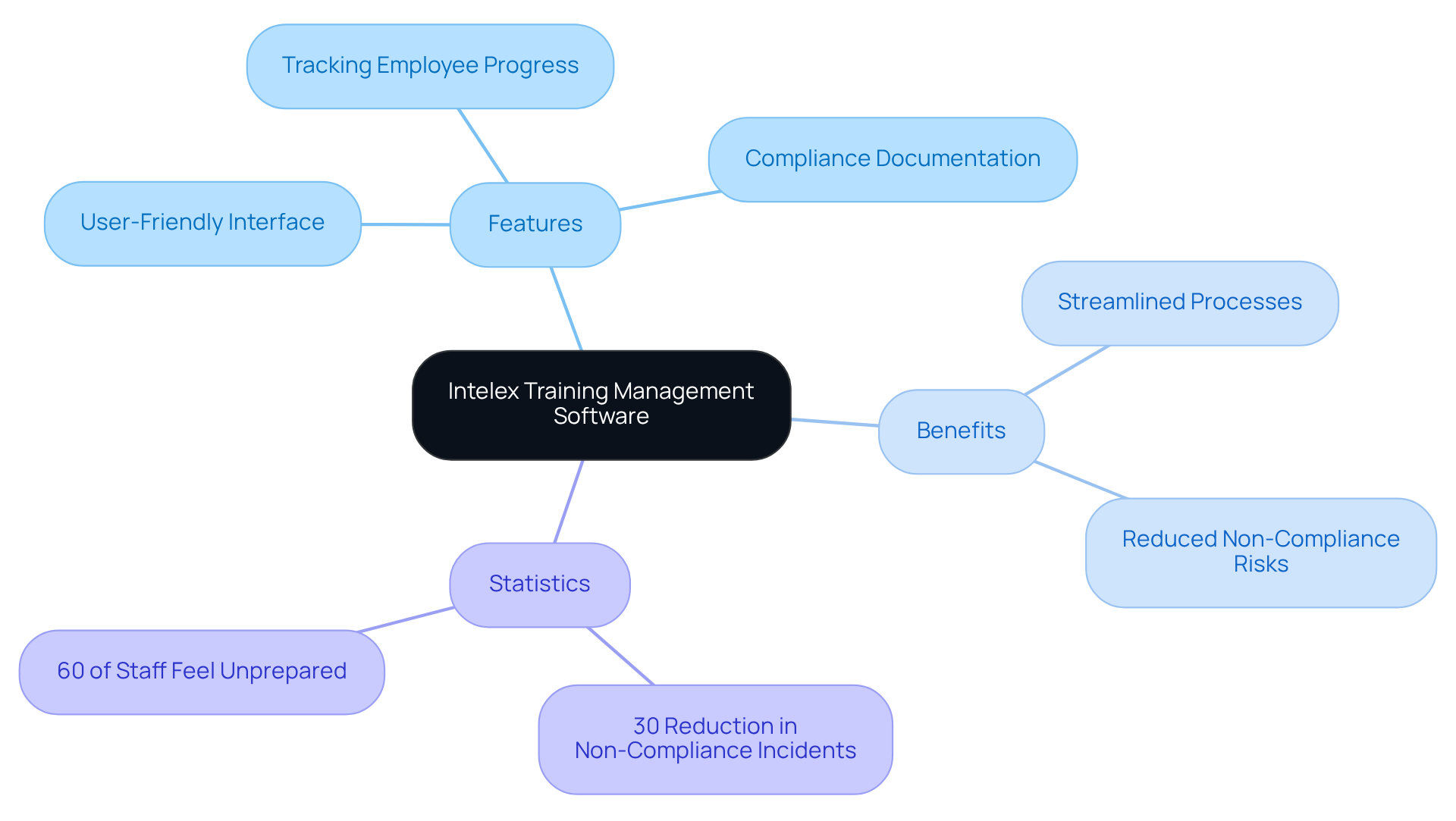
Real-Time Tracking: Monitor Employee Training Progress Effectively
You might be wondering how real-time tracking can really make a difference in overseeing . Well, it’s a game-changer! This approach gives organizations immediate insights into how staff are doing, from completion rates to engagement levels. Managers can quickly spot where team members might be struggling and tweak development programs on the fly. For example, companies that embrace often see a 20-30% bump in and a 15% increase in productivity.
And it gets even better! Organizations that invest in education typically enjoy a 24% higher profit margin. That’s right— not only help your team grow but also . By tapping into real-time information, companies can foster accountability and ensure that educational goals are consistently achieved, leading to improved performance and productivity.
Speaking of engagement, did you know that Gallup found "high engagement leads to 41% lower absenteeism and 22% higher profitability"? This really underscores the importance of , engaged workforce. Many organizations that have adopted tracking have seen fantastic improvements in educational outcomes.
Plus, there’s this striking statistic: '94% of employees are likely to stick around longer if their company invests in their .' This really makes a strong case for the value of effective education and oversight. A great example of this is the case study 'Continuous Improvement through Data Analysis,' which shows how to enhance learning outcomes. So, how about diving deeper into how these strategies can work for you?
![]()
Automated Workflows: Enhance Efficiency in Training Delivery
You might be wondering how in delivering instruction. Well, they do wonders for efficiency by and . Imagine being able to set up educational sessions, send reminders, and keep track of completions—all without needing to supervise constantly. Sounds great, right? This not only saves you a ton of time—research shows that ! Plus, 73% of IT leaders have noted similar reductions. But that’s not all; it also helps reduce errors, letting managers focus on crafting and connecting more effectively with their teams.
Now, let’s dive into some numbers:
- 85% of business leaders agree that lets employees focus on strategic goals.
- 42% recognize that , freeing up employees to engage in more strategic activities.
Ultimately, this all leads to a . So, how can you start leveraging automation in your organization? Let’s explore some options together!
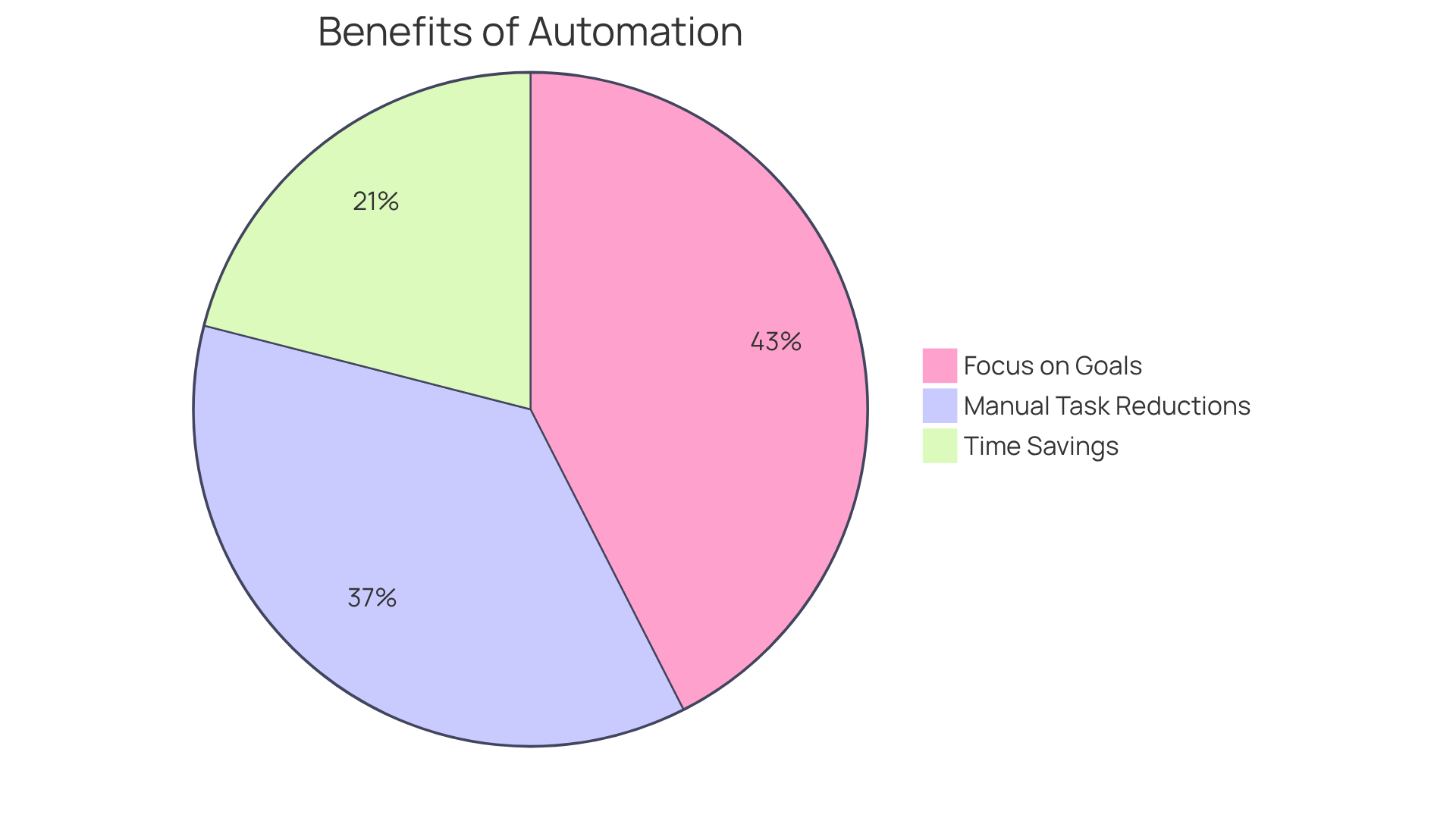
Expert Training Content Access: Elevate Training Quality
You might be wondering why access to is so crucial for improving educational programs. Well, organizations can really benefit from curated resources like industry best practices, case studies, and expert-led webinars. These resources can be effortlessly woven into their educational modules. By tapping into this specialized knowledge, companies empower their staff with the most relevant and effective tools provided by , leading to better performance and results.
For instance, organizations that invest in often see a noticeable and knowledge retention. Research indicates that well-organized employee training management software can increase productivity by as much as 20%, as employees feel more prepared to handle their roles efficiently.
Speaking of boosting engagement, statements from industry leaders really drive home the importance of incorporating . Take Richard Branson, for example—he emphasizes the need to prepare individuals so they feel free to leave, while also treating them well enough that they choose to stay. This highlights the dual benefit of investing in quality education, as employee training management software enhances both employee satisfaction and performance.
Now, let’s dive into some real-world examples. Organizations that have successfully implemented employee training management software report significant improvements in the quality of education. A notable tech company, for example, rolled out a tailored skill development strategy that led to a 30% increase in project completion rates and a marked decrease in onboarding time for new hires.
In conclusion, employee training management software that incorporates curated educational materials not only boosts the but also fosters a and improvement, ultimately driving organizational success. Operations managers can take their development initiatives to the next level by leveraging to streamline the creation and management of educational materials, ensuring that all resources stay relevant and accessible.
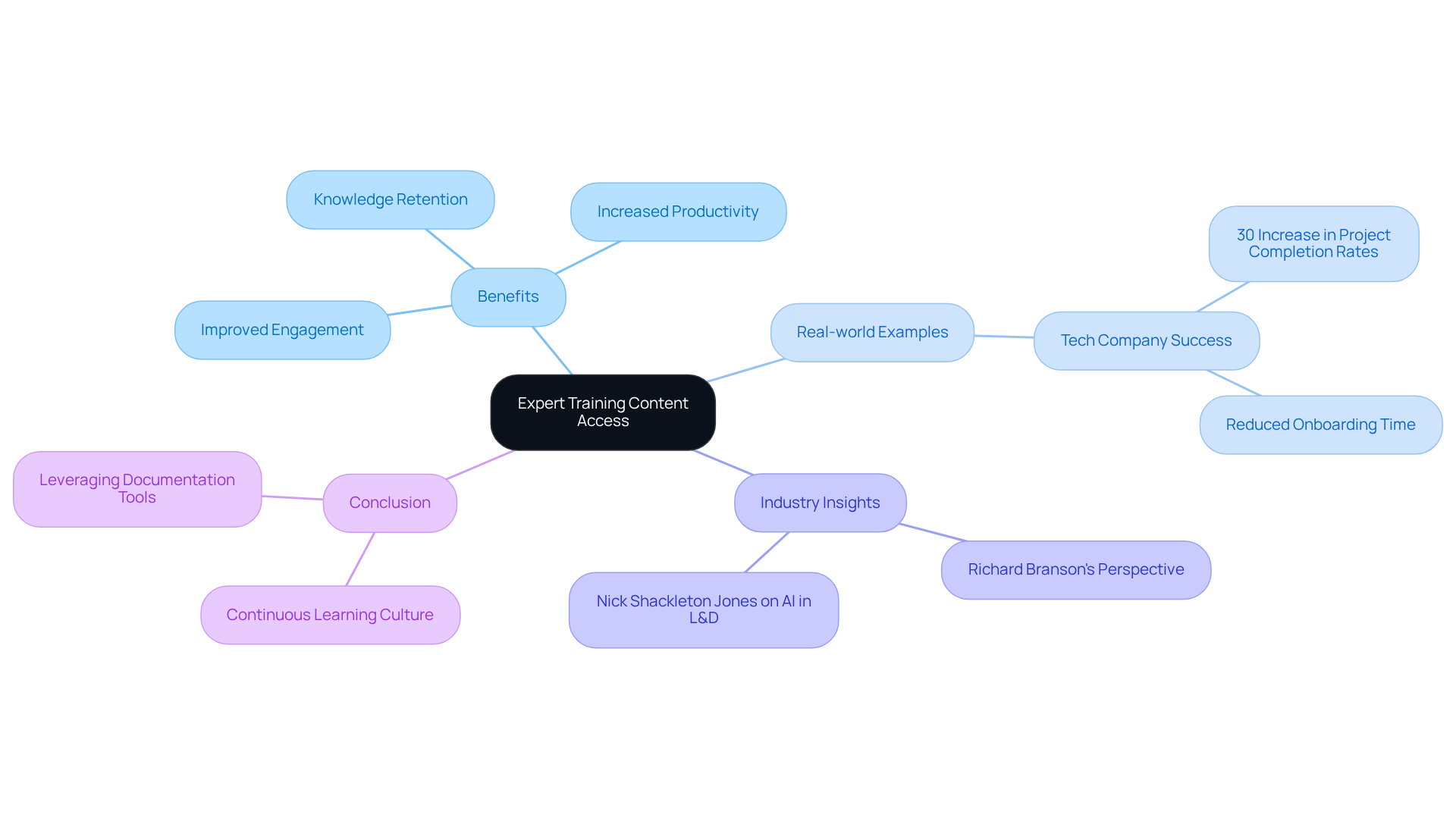
Insights and Reporting: Analyze Training Effectiveness
You might be wondering how insights and reporting tools can really make a difference in evaluating instructional effectiveness. Well, by systematically gathering and examining data on things like staff performance, completion rates, and feedback, companies can uncover valuable insights into what’s working and what isn’t in their . This helps managers make informed choices, improve content, and implement changes that really boost overall effectiveness and .
For instance, organizations that frequently check in on skill acquisition often report a 40% . That’s a pretty impressive benefit of having a solid analytics framework, right? And it doesn’t stop there—firms that invest in extensive education initiatives see a 24% greater profit margin compared to those that don’t prioritize staff growth. So, it’s clear that leveraging data analytics not only enhances but also aligns learning strategies with organizational goals, promoting a culture of ongoing development.
Now, speaking of effectiveness, did you know that 68% of employees feel the instruction they receive is adequate for their role? This really highlights the of educational programs. Customizing development programs to meet learner needs is crucial for maximizing resources and hitting those learning objectives. So, let’s dive into how you can make this work for your organization!
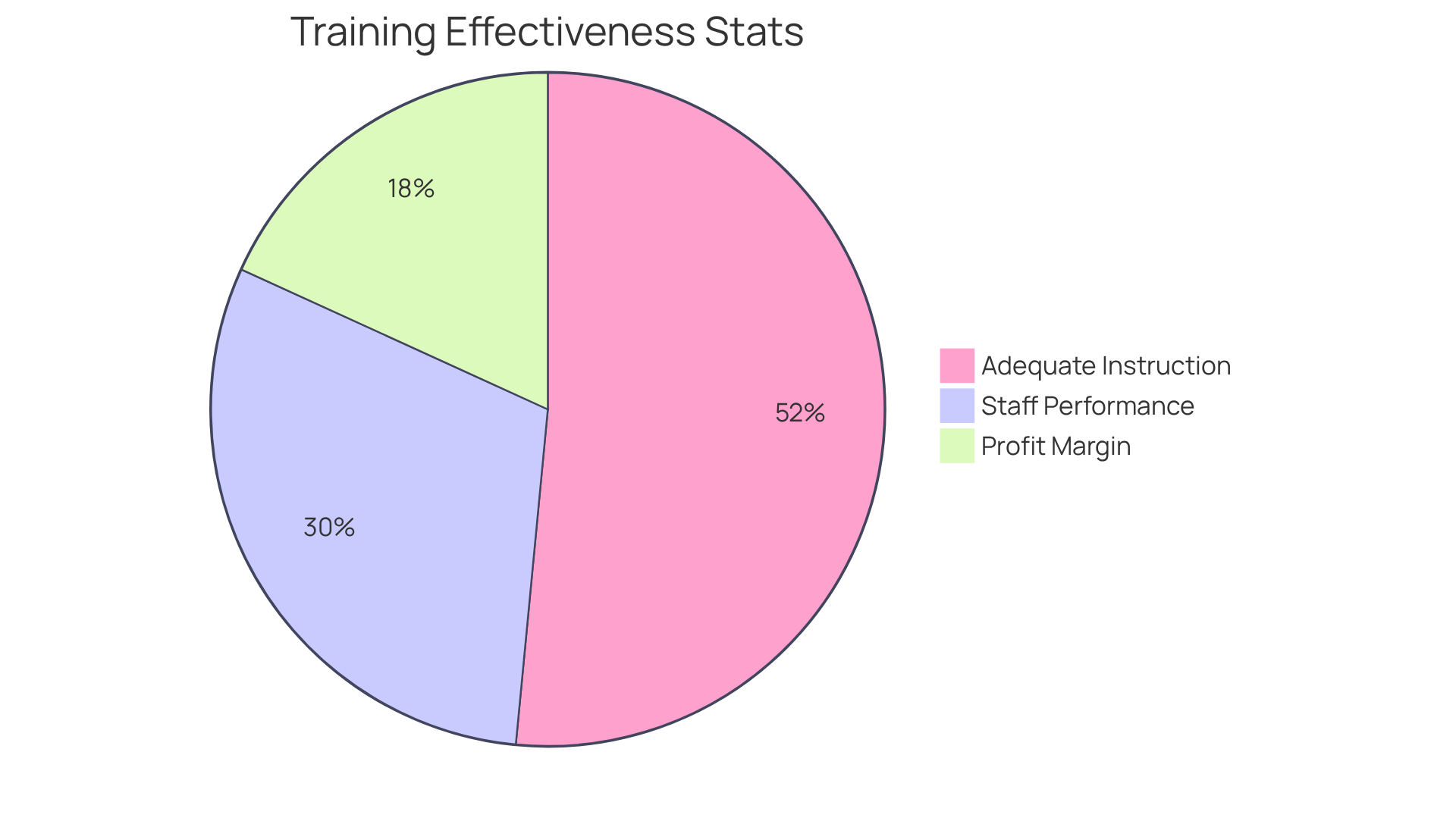
Compliance Tracking: Ensure Regulatory Adherence
You might be wondering why monitoring adherence is such a big deal for educational programs. Well, it’s essential for companies to meet those pesky . By implementing comprehensive tracking systems, businesses can use to monitor , certifications, and . This proactive approach not only helps avoid penalties but also builds a and .
Did you know that companies with ongoing development programs see a whopping 60% increase in compliance with policies? That’s a clear sign of how organized learning can boost overall performance! And here’s another interesting tidbit: 70% of organizations that conduct skills evaluations report higher compliance levels. This really highlights the .
For instance, companies that implement employee training management software for continuous compliance training have noticed a 50% increase in employee awareness of compliance mandates. That’s crucial for ! Industry leaders stress that fostering an ethical culture of compliance is key, with 76% of risk and compliance professionals underscoring its importance in decision-making.
Now, let’s talk numbers—non-compliance can cost a company around $14 million each year! That’s a hefty price tag for not keeping up with compliance oversight. By using effective , organizations can protect themselves from regulatory violations and enhance their operational integrity and reputation.
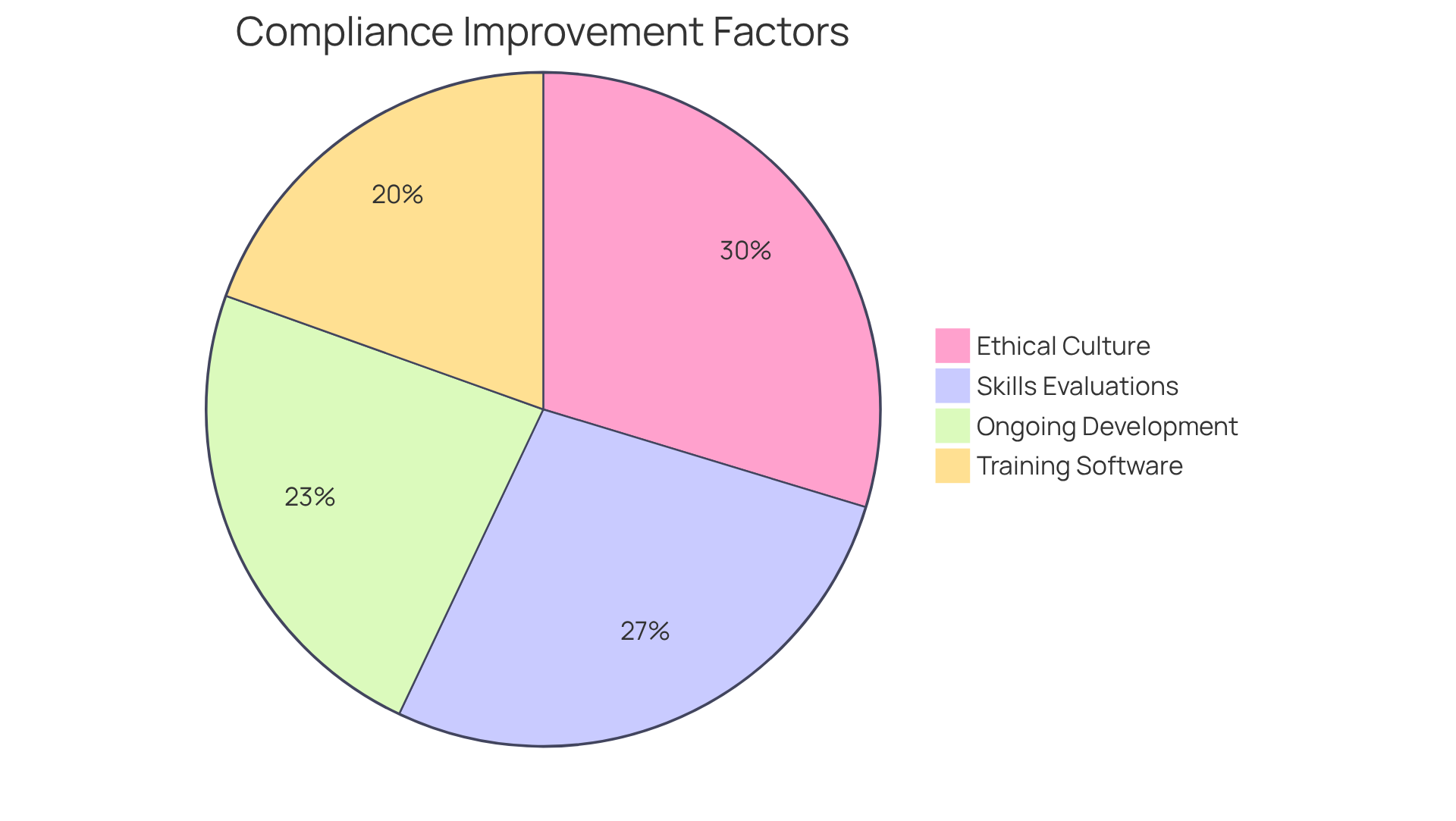
Automated Training Workflow: Optimize Management Processes
You might be wondering how can really change the game for management processes. Well, they significantly lighten the load of and make everything run a lot smoother. By automating essential tasks like scheduling, reminders, and reporting, organizations can reclaim precious time to develop their managers. This means they can focus more on strategic initiatives instead of getting bogged down in paperwork.
Not only does this optimization , but it also enhances the overall development experience for staff. Imagine better engagement and improved knowledge retention! Employees estimate they could save around 240 hours a year thanks to task automation, while business leaders think it could be as much as 360 hours. Organizations that have embraced for automating instruction are experiencing similar time savings, enabling managers to focus more on developing .
As one development manager put it, "Automation has drastically reduced the administrative workload, enabling us to concentrate on enhancing the quality of our instruction delivery." Plus, a whopping 86% of staff members believe automation will help them work more efficiently, highlighting its positive impact on productivity. This shift not only ramps up but also creates a more engaged workforce, as employees benefit from a .
Now, here’s a striking fact: 94% of businesses are stuck doing repetitive, , which really underscores the need for automation in skill development. But let’s not forget the flip side—90% of automation projects end up failing due to technical hiccups. This really emphasizes how crucial is when it comes to implementation.
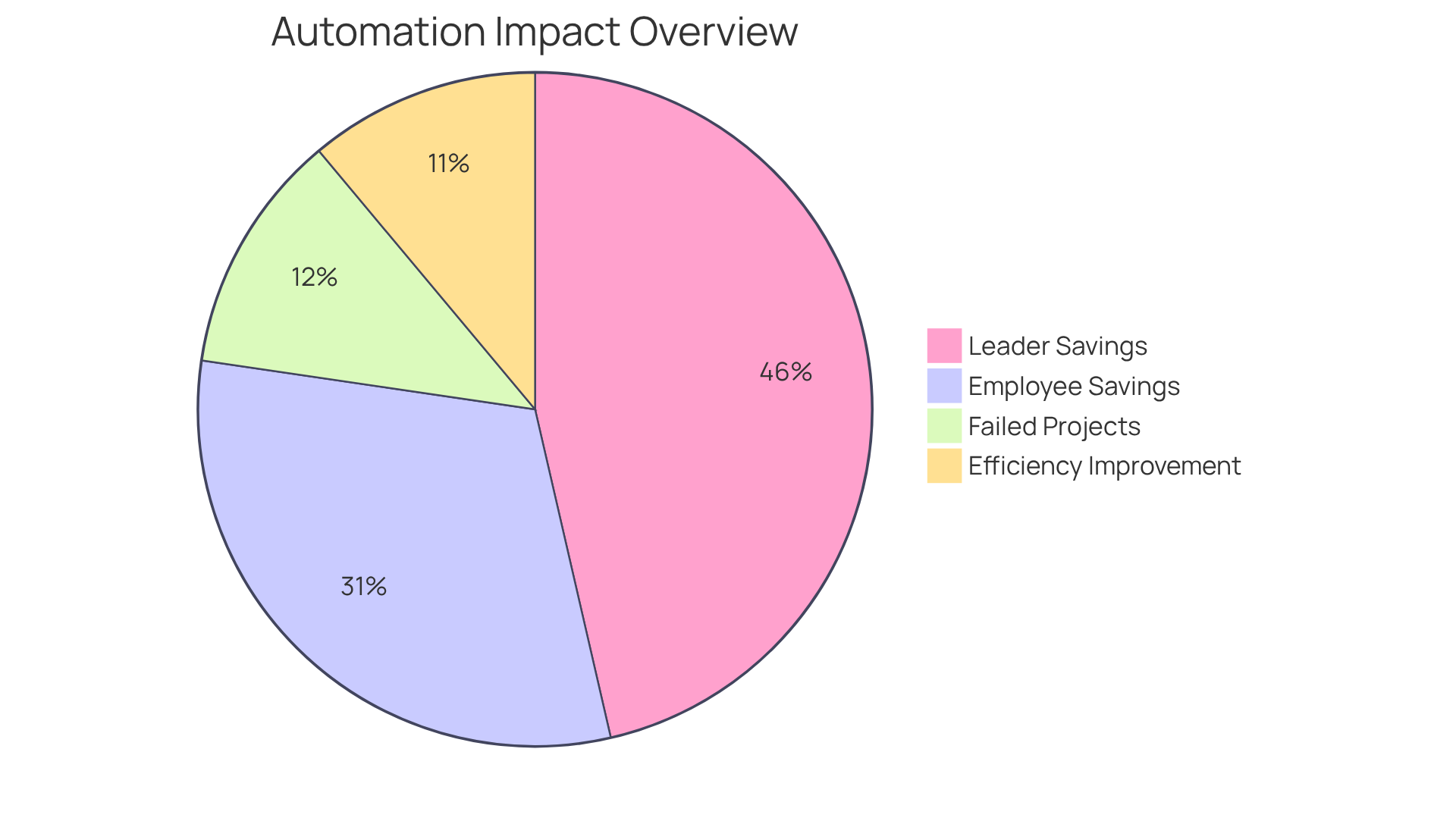
EHSQ Management Integration: Simplify Training Processes
You might be wondering how incorporating Environmental, Health, Safety, and Quality (EHSQ) management into educational processes can make a difference. Well, it turns out that doing so significantly simplifies operations and boosts compliance! When companies align their development programs with , they ensure that their staff are well-versed in and regulatory requirements. This not only enhances the educational experience but also nurtures a and responsibility within the organization.
Now, let’s dive into some interesting stats:
- Businesses that provide at least 20 hours of training each year are 68% more likely to have employees sticking to safety protocols.
- Organizations that prioritize EHS education see a whopping 218% increase in income per employee.
- A 17% boost in productivity.
This really shows how effective training can lead to better employee performance! But here’s a challenge: 42% of EHS experts say that , which highlights the need for solid management solutions.
Speaking of solutions, companies like Vaya Space have jumped on board with EHS software to manage safety protocols and compliance. This has led to improved safety standards and a stronger safety culture overall. And as Meghan puts it, "The idea was for these documents to be readily accessible in case of an emergency," which really underscores how important digital records are for EHS compliance. So, by utilizing EHSQ standards, companies can streamline their educational processes with , ensuring that everyone receives the they need to meet legal requirements and enhance workplace safety. Isn't that something worth exploring further?
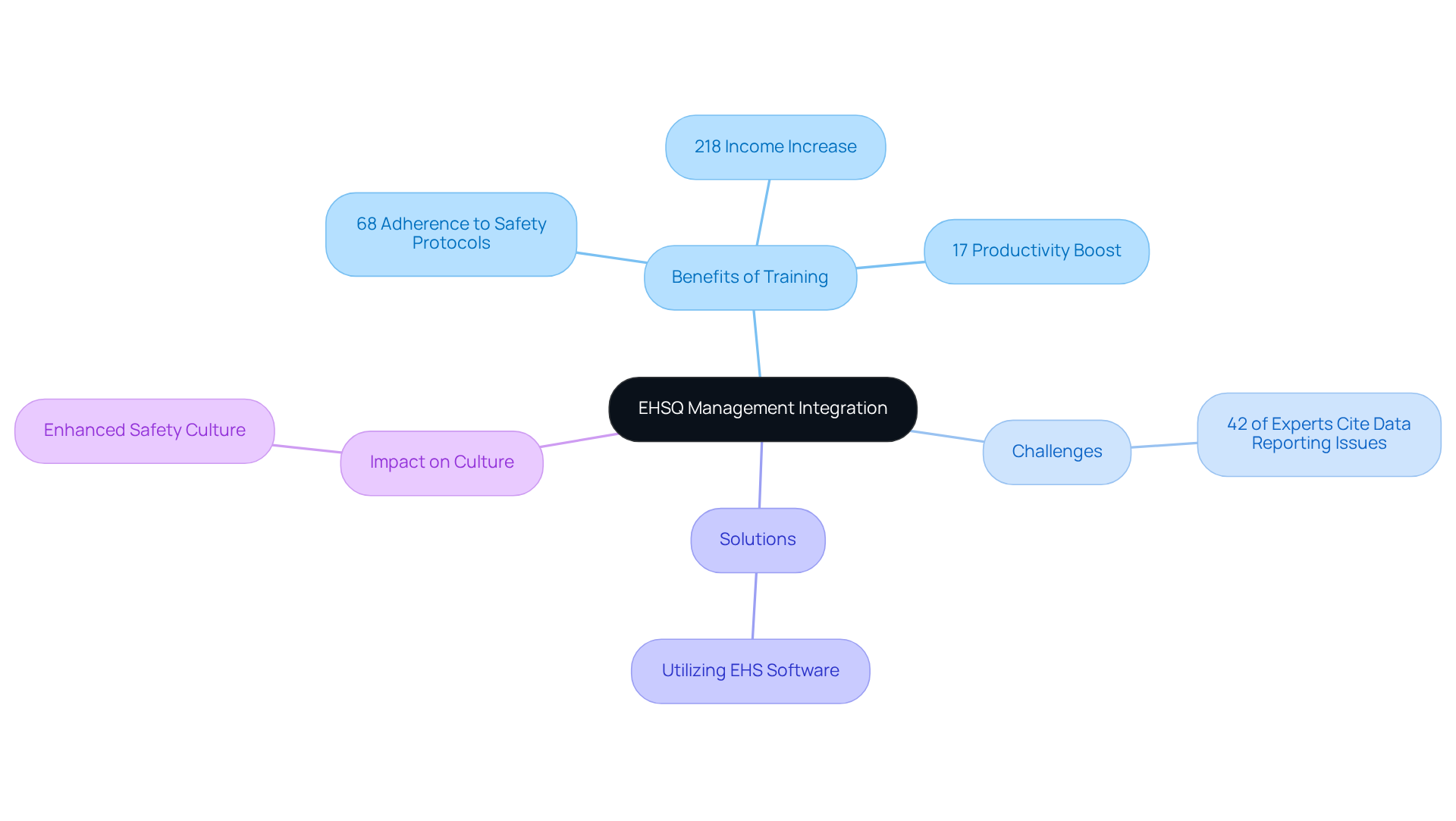
EHSQ Success: The Critical Role of Training Management Software
You might be wondering how can really make a difference in Environmental, Health, Safety, and Quality (EHSQ) initiatives. Well, it plays a pivotal role! By providing a , companies can effectively monitor compliance and evaluate performance metrics. This not only leads to substantial improvements in EHSQ outcomes but also simplifies , ensuring employees get the essential instruction they need to meet regulatory requirements and promote a safe working environment.
Now, let’s dive into why matters. It streamlines the administration of educational programs while boosting accountability and transparency across the board. For instance, organizations that adopt these systems often report because they can easily track course completion and identify knowledge gaps. Research even shows that companies with strong development oversight systems experience a 20% reduction in compliance violations. That really underscores how critical these tools are for maintaining !
Industry leaders are all on board with the value of centralized platforms. One expert put it perfectly: "Our system is perfectly designed to get us the results we're getting. If we want different results, we need a different (improved) system." This highlights the importance of developing oversight methods to achieve better outcomes. A former plant manager also emphasized, "Don't tell me what you think is happening. Don't tell me what should be happening. Tell me what IS occurring," showcasing how vital are in managing programs effectively.
Furthermore, organizations that have embraced learning software have seen some impressive enhancements in their EHSQ performance. Take, for example, a manufacturing firm that adopted a centralized learning platform—it reported a 14% rise in productivity and a significant drop in workplace incidents. This case illustrates that efficient instruction oversight not only boosts safety but also contributes to operational effectiveness. Plus, companies with highly engaged staff experience a whopping 70% decrease in safety incidents, reinforcing how effective centralized instruction oversight can be in enhancing safety results.
In conclusion, if you're looking to elevate your , investing in employee training management software is essential. By ensuring staff members are well-trained and compliant with safety regulations, companies can create a safer workplace and drive overall business success. As Claire Styles pointed out, demonstrating how an EHS tool saves money and drives value is crucial for making a strong case for investment. And let’s not forget about building a feedback loop for continuous improvement—this is vital for enhancing safety and efficiency, ensuring organizations can adapt and thrive in a dynamic environment. With 75% of employees prioritizing feeling safe and secure at work, the importance of really cannot be overstated.
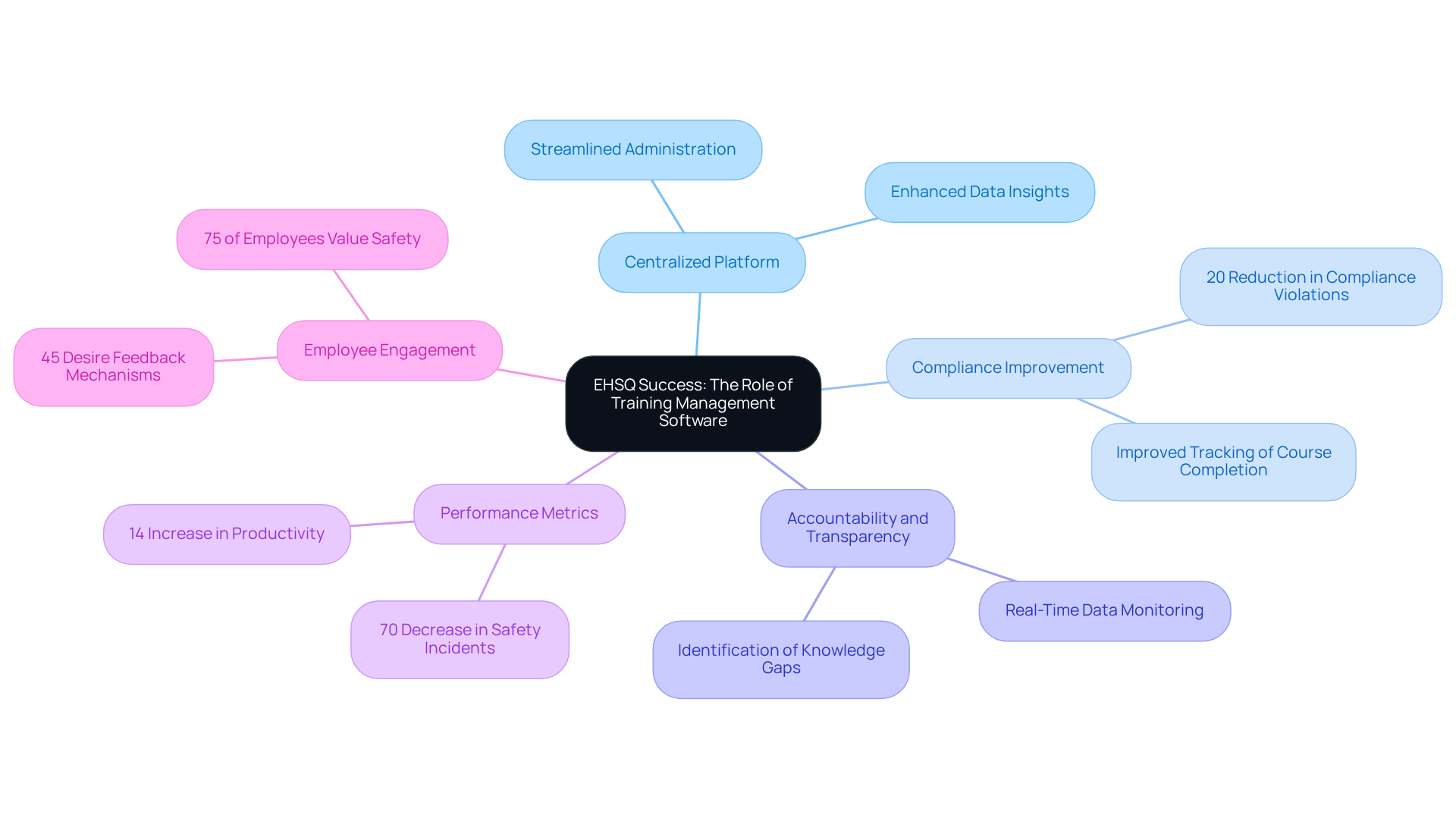
Conclusion
Investing in employee training management software is super important for organizations looking to boost their workforce development and compliance. This software doesn't just make training processes easier; it also ensures that employees have access to the latest information, resources, and feedback they need to grow. By leveraging features like real-time tracking, automated workflows, and expert content access, businesses can create a solid training environment that promotes continuous improvement and accountability.
You might be curious about what makes employee training management software so essential. Throughout this article, we’ve explored key features such as:
- Compliance tracking
- The perks of automated workflows
- How expert training content can enhance employee performance
Each of these elements plays a crucial role in optimizing training delivery and keeping organizations compliant with industry regulations. The stats we've shared really highlight the tangible benefits of these systems, like increased employee engagement, better productivity, and improved compliance rates.
So, why is effective training management such a big deal? Organizations that make comprehensive training solutions a priority not only empower their employees but also set themselves up for long-term success. As the world of workforce development keeps evolving, embracing these tech advancements will be key to staying competitive. Companies are encouraged to check out the latest trends in employee training management systems and invest in tools that align with their strategic goals, ensuring a well-prepared and compliant workforce ready to tackle tomorrow's challenges.
Frequently Asked Questions
What is SowFlow and how does it help with training management?
SowFlow is a tool that allows organizations to instantly create Standard Operating Procedures (SOPs), which streamlines workforce management by reducing the time spent on creating instructional materials and ensuring employees have access to the latest information.
How does SowFlow benefit employee onboarding and development?
SowFlow simplifies the onboarding process for new employees and supports the ongoing development of current staff by ensuring everyone is aligned with the latest procedures and standards.
What is Intelex Training Management Software designed to do?
Intelex Training Management Software is designed to streamline educational processes while ensuring compliance with industry regulations. It allows companies to set up training sessions, track employee progress, and manage compliance documentation in one platform.
How does Intelex reduce the risk of non-compliance?
By providing a structured educational environment and advanced development oversight systems, Intelex can help organizations reduce non-compliance incidents by up to 30%.
What impact does real-time tracking have on employee training?
Real-time tracking provides organizations with immediate insights into employee training progress, allowing managers to identify struggles and adjust programs as needed, leading to improved engagement and productivity.
What are the benefits of investing in employee education?
Organizations that invest in employee education typically experience a 24% higher profit margin, increased employee engagement, and improved performance, with data-driven strategies leading to significant gains in productivity.
How does employee engagement relate to training and development?
High employee engagement is linked to lower absenteeism and higher profitability. Companies that invest in career development see a higher retention rate, with 94% of employees likely to stay longer if their company supports their growth.
Can you provide an example of how real-time data tracking improves learning outcomes?
The case study 'Continuous Improvement through Data Analysis' illustrates how organizations can leverage real-time data to enhance learning outcomes, leading to better educational results and overall workforce competency.
👍
What others are liking
5 Steps to outline your ideal documentation structure
5 MINS READ
Where to start the your journey of mapping out your ideal documentation structure, aligning it with the very heartbeat of your organization?
Defining a winning level of detail in your process
3 MINS READ
What is too much detail, and what is too little? This article described in that winning level detail about what detail is enough.





